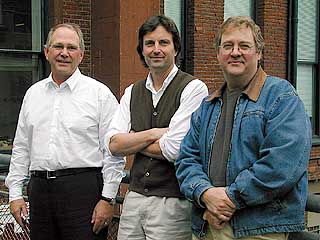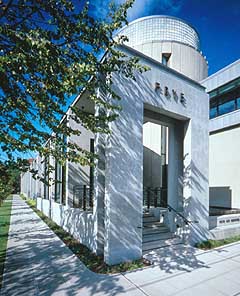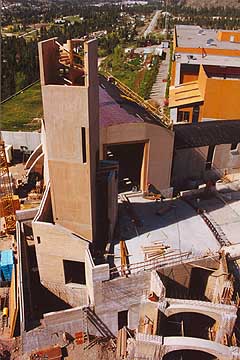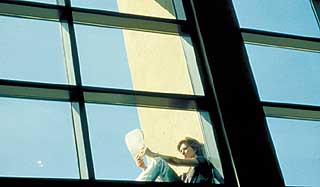
A&E Perspectives
Survey Index
Award Winners
DJC.COM
November 16, 2000
The delight of a slow opera
Olson Sundberg Kundig Allen is nationally recognized for design of contemporary residences and for urban buildings that serve institutions of culture, education and religion.

|
The firm designed the Frye Art Museum and has been a part of the design team for the Seattle Art Museum and the Chapel of St. Ignatius at Seattle University. It is currently at work on Mission Hill Winery in Kelowna, B.C., the Newman Center near the University of Washington campus and a new building for Whatcom Community College in Bellingham. In the interview reproduced below, principals Rick Sundberg, Tom Kundig, and Scott Allen talked with writer Dyan Hoblitzell. (The fourth partner, who was not present, is Jim Olson.)
DH: What is the relationship between your residential work and your institutional work?
SA: One certainly informs the other and makes all the work richer. After all, the same people that erect public buildings live in homes.
RS: In terms of our nonresidential projects, I think that our residential work influences it a lot more than we realize. When I work on museums, like the Frye Art Museum, there is no question that the residential work influences it in terms of the use of color and scale and the care of the detailing.

|
I think that our bent might be to take that into the future: the care, attention to detail, and intimacy that is expressed in the level of scale and color. It means you have to go back and forth. You need to have some intimate spaces where one or two people can have a comfortable conversation, and you need to be able to gather 100 people. But I think that we are interested in taking that notion and developing it in nonresidential projects. Ultimately, I think that is what people really respond to.
TK: It is making decisions at the macro-scale with an understanding of what the micro needs are, that is what brings a certain richness to our projects. Beyond that, we see a need for an intermediate scale that bridges the large scale to the small scale. We hope that we can foster a change in that direction.
DH: What about designing institutional or public realm projects appeals to you as a firm?
TK: The public realm has an effect on us culture-wide. The private home certainly has an effect at the micro level. But in a public building, for example, at the (Mission Hills) Winery, 200,000 people will be invited into this special place. Since we are environmental designers, we hope that a ripple effect will take place in the community and culture.
DH: Is there an urge to go and watch how people interact with the building?

|
RS: Of course. Sometimes you do. I watch people to see what they are doing and how they are reacting.
SA: I think everyone wants to a make the world a better place. It is pretty gratifying to go back to the School of Law at Seattle University that we completed about a year ago. I stand in the courtyard, which we fought for tooth and nail. It is literally peopled with students hanging out, studying, and talking. I am anonymous when I walk by. No one really knows.
TK: It is the same reason why there is a composer who creates music or an artist. It is for the public. I am sure there are composers and artists who compose work solely for themselves. But I think that most of them would say that they like to see it performed in a public venue.
SA: Architecture is real slow opera.
TK and RS: Really slow.
DH: What have been your most successful projects in the public realm? How does your firm define success?
RS: How many awards does it get? That is one way of measuring it. But I don’t know if that is the true measure. If you step back, how satisfied we are and the clients are. I look at the School of Law as being a very successful project. It may or may not win awards.
SA: Another measure of success is the projects that we look to most consistently for inspiration on the next project. There is an assortment of things that we learn, including some things that we would probably not want to do again. Some become an inspiration in the details, attitudes, and moods, which we can grab onto and use as a springboard for more creative work. Certainly it is not a matter of replicating it, but it is a matter of interpreting it for the next unique situation. We use a lot of the information that we have gotten from the Frye. I suspect we will do that on the School of Law, the Winery, and the other projects as we move forward.
TK: I think that there is internal team success: They can gauge the success of that building because they were there during the design process. They know all of the lessons and the compromises. They know what they conceived, against all odds in many cases, was this incredibly successful project. Then there is another level of success. For me, a good building gets better over time. I think you have to wait for 10 years, 20 years or 50 years. Because that is what architecture is about—this long opera that Scott has been talking about. In our profession, you need to let it age.
SA: I guess the other measure of success, which amplifies what Tom was saying, relates to the client’s expectations and value system. You have to connect with them, you have to encourage them, you have to be tenacious, and you have to push for your point of view. And when you succeed, it translates to the architecture. When we are successful, we have a way of bringing our clients into the process that makes them champion our cause as much as we do.
DH: How do you find clients that you are well matched with?
TK: We think that there is a certain self-editing that happens out there before clients contact us. They know that we will engage them significantly into the project because we expect this co-spark that happens between the client and us. This goes back to what Scott was talking about. You build something better than either individual expected because of this collaboration.
RS: I think that is a lesson that comes from our residential side, where we really engage our client. We usually encourage their active participation. We show our clients a lot of alternatives. We want them engaged in the process so they ultimately have ownership of the design. At the School of Law, our clients loved the design process, and they contributed in a psychological and spiritual way.
SA: So the soul comes out of it.
TK: Exactly. Our job as architects is to assemble that soul into the building as we interact with our clients.
DH: People always talk about value in their buildings, but what about delight?

|
TK: Delight is value. I think that is something that people sometimes forget. Enjoying the building is enormous value. People are beginning to understand that good facilities mean good businesses. What is the work environment like? What is the design? If they are interested in a quality space and a quality building, they probably have a reinvestment attitude.
SA: ... And they value their people.
TK: Sometimes I think people confuse delight with witty irony or festival architecture. We are not talking about that sort of veneer frivolity. We are talking about “second glance architecture” or architecture that gets better as you recognize nuances as the buildings ages. You will not see it during the first or second go around. But the more you experience this place, the more you recognize this care and love that was put into the building by an entire group. Delight is perpetual: you are continually discovering things about the building.
DH: How do you stand up for the idea of delight when confronted with the very real constraints of budgets, public process, and functionality?
TK: Delight does not have to necessarily cost more than no delight. There are a number of buildings that I think that we have all experienced that have absolutely no delight to them at all. It is the way the designers have gone about it, thought about what they are doing, and put their own delight into it.
SA: And it does not have to be done at the cost of functionality ... or firmness, commodity and delight.
TK: It [delight] can happen at the detail level too. As architects, we are applied artists, not fine artists. We are given a problem to solve that is based on function. When a client comes to you with a program, you are trying to functionally solve it. You can take all the parts, understand their function, and do something with it and be creative. Sometimes that happens, quite frankly, at the craft level when you are working with a craftsperson on-site. We may think of a way of solving it. But the craftsperson has been working with the material their entire lives. They can come up with a proposal to do it in such a way that is fantastic because it is so complete.
I think that delight is actually driven by function. It is just the way that you actually resolve the solution.
SA: ... And the values you bring to it.
DH: How is this going to take the firm forward?
TK: We are just going to try and do the best possible work that we can do. Hopefully we will hook up with good clients that spark us and we spark them. For us, that is our driver: good clients. We will respond. There is also an expectation from the bottom to the top that you can never really stop moving or stop thinking because there is a culture of just expecting the best that keeps us all on our toes. It is a good thing because it is that last thing to do that is so hard. It really is true that it takes 80 percent of the effort to get that last little bit ... that improvement. Ultimately it is worth it.
Other Stories:
- NW architects prosper…and the community benefits
- The new airport has arrived
- Making chaos work for you: keys to small firm management
- Little Yelm sets big environmental goals — and meets them
- Making space for the spirit in a medical facility
- Putting power back into public process
- Engineers build new sites on the Web
- Extending boundaries in the performance arts
- Perfecting Pier 56
- Speed
- Thriving engineering field competes for tech talent
- Tacoma leads in light rail construction, station design
- Architecture for the knowledge economy
- Technology space, from core to shell
- The sun never sets on the extranet
Copyright ©2009 Seattle Daily Journal and DJC.COM.
Comments? Questions? Contact us.